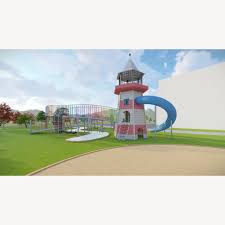Creating a safe playground environment is critical, as it directly impacts the well-being and development of children. Ensuring that Playground Equipment is safe for all ages involves meticulous design, adherence to safety standards, and ongoing maintenance. Here's a step-by-step guide to guaranteeing the safety of playground facilities for children of various age groups.
Comply with Safety Standards
The first step in ensuring playground safety is compliance with established safety standards and guidelines. In the United States, the Consumer Product Safety Commission (CPSC) and the American Society for Testing and Materials (ASTM) provide detailed guidelines that cover everything from the spacing between equipment to the depth and type of surfacing materials. For instance, the CPSC recommends that spaces which could trap children (like openings in guardrails or between ladder rungs) must measure less than 3.5 inches or more than 9 inches to prevent head entrapment.
Age-Appropriate Design
Playground equipment should cater specifically to the developmental needs and abilities of different age groups. Equipment designed for toddlers (ages 2-5) should have lower heights and require minimal climbing. For older children (ages 5-12), equipment can offer more complex features, such as taller slides and climbing walls, to challenge their growing motor skills and strength. Clear signage indicating the appropriate age for each piece of equipment can help prevent accidents by ensuring that children use equipment that matches their developmental stage.
Durable and Safe Materials
The materials used in playground equipment must be durable and non-toxic to withstand heavy use and exposure to various weather conditions without deteriorating. Use of rust-resistant metals, splinter-free wood, and UV-protected plastics ensures the longevity and safety of the equipment. Furthermore, all fasteners and connectors should be secure and tamper-proof to prevent injuries.

Install Protective Surfacing
Falls are the most common playground injury, making protective surfacing a critical safety feature. Recommended materials include poured-in-place rubber, rubber mulch, engineered wood fiber, or sand. These materials should be installed to a proper depth, determined by the height of the equipment, to cushion falls effectively. According to ASTM standards, surfacing should extend at least 6 feet in all directions from the equipment, with additional coverage depending on the height and type of equipment.
Regular Inspections and Maintenance
Ongoing inspections and maintenance are crucial to keeping playground equipment safe. Regular checks can identify potential hazards like loose bolts, worn-out parts, and vandalism before they cause accidents. A routine maintenance schedule should include tasks such as tightening hardware, replenishing loose-fill surfacing, and repairing damaged equipment.
Community Involvement
Engaging the community in the safety process can enhance the overall effectiveness of safety measures. Encouraging parents and caregivers to report any safety issues they observe can help address potential problems quickly. Community training sessions on playground safety can also raise awareness and promote proactive surveillance.
Risk Management
While it is crucial to minimize risks, it is also important to remember that some level of risk is essential for children's development. Balancing safety with opportunities for children to challenge themselves helps them learn risk assessment and develops their physical and cognitive skills.
In conclusion, ensuring that playground equipment is safe for all ages requires a multifaceted approach that includes strict adherence to safety standards, thoughtful design, rigorous maintenance, and community engagement. By taking these steps, communities can create play environments where children feel secure and free to explore their limits safely.
